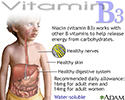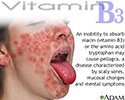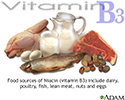Niacin
Nicotinic acid; Vitamin B3
Niacin is a type of B vitamin. It is water-soluble, which means it is not stored in the body. Water-soluble vitamins dissolve in water. Leftover amounts of the vitamin leave the body through the urine. That means you need a regular supply of such vitamins in your diet.
Function
Niacin helps the digestive system, skin, and nerves to function. It is also important for converting food to energy.
Food Sources
Niacin (also known as vitamin B3) is found in:
- Milk
- Eggs
- Enriched breads and cereals
- Rice
- Fish
- Lean meats
- Legumes
- Peanuts
- Poultry
Niacin and Cardiovascular Disease
For many years, doses of 1 to 3 grams of nicotinic acid per day has been a treatment option for low HDL cholesterol and high LDL cholesterol and triglyceride levels.
Side Effects
A deficiency of niacin causes pellagra . The symptoms include:
Pellagra
Pellagra is a disease that occurs when a person does not get enough niacin (one of the B complex vitamins) or tryptophan (an amino acid).

- Digestive problems
- Inflamed skin
- Mental impairment
Large doses of niacin can cause:
- Increased blood sugar (glucose) level
- Liver damage
-
Peptic ulcers
Peptic ulcers
A peptic ulcer is an open sore or raw area in the lining of the stomach or intestine. A gastric ulcer occurs in the stomach. A duodenal ulcer occurs ...
 ImageRead Article Now Book Mark Article
ImageRead Article Now Book Mark Article -
Skin rashes
Skin rashes
Rashes involve changes in the color, feeling or texture of your skin.
 ImageRead Article Now Book Mark Article
ImageRead Article Now Book Mark Article
Even normal doses can be associated with feeling warmth, redness, itching or tingling of the face, neck, arms or upper chest. This is called "flushing". In most cases, this problem will get better after taking niacin on a regular basis for a while. To prevent flushing, do not drink hot beverages or alcohol at the same time you take niacin. New forms of nicotinic acid reduce this side effect. Nicotinamide does not cause these side effects.
Recommendations
Reference Intakes
Recommendations for niacin and other nutrients are provided in the Dietary Reference Intakes (DRIs), which are developed by the Food and Nutrition Board at the Institute of Medicine. DRI is the term for a set of reference values that are used to plan and assess the nutrient intakes of healthy people. These values, which vary by age and gender, include:
- Recommended Dietary Allowance (RDA): average daily level of intake that is enough to meet the nutrient requirements of nearly all (97 to 98%) healthy people.
- Adequate Intake (AI): when there is not enough evidence to develop an RDA, the AI is set at a level that is thought to ensure enough nutrition.
Dietary Reference Intakes for Niacin:
Infants
- 0 to 6 months: 2* milligrams per day (mg/day)
- 7 to 12 months: 4* mg/day
*Adequate Intake (AI)
Children (RDA)
- 1 to 3 years: 6 mg/day
- 4 to 8 years: 8 mg/day
- 9 to 13 years: 12 mg/day
Adolescents and Adults (RDA)
- Males age 14 and older: 16 mg/day
- Females age 14 and older: 14 mg/day, 18 mg/day during pregnancy, 17 mg/day during lactation
Specific recommendations depend on age, gender, and other factors (such as pregnancy). Women who are pregnant or breast-feeding need higher amounts. Ask your health care provider which amount is best for you.
The best way to get the daily requirement of essential vitamins is to eat a balanced diet that contains a variety of foods.
References
AIM-HIGH Investigators. The role of niacin in raising high-density lipoprotein cholesterol to reduce cardiovascular events in patients with atherosclerotic cardiovascular disease and optimally treated low-density lipoprotein cholesterol Rationale and study design. The Atherothrombosis Intervention in Metabolic syndrome with low HDL/high triglycerides: Impact on Global Health outcomes (AIM-HIGH). Am Heart J . 2011 Mar;161(3):471-7.e2. PMID: 21392600 www.ncbi.nlm.nih.gov/pubmed/21392600 .
Institute of Medicine, Food and Nutrition Board. Dietary Reference Intakes: Thiamin, Riboflavin, Niacin, Vitamin B6, Folate, Vitamin B12, Pantothenic Acid, Biotin, and Choline. National Academy Press . Washington, DC, 1998. PMID: 23193625 www.ncbi.nlm.nih.gov/pubmed/23193625 .
Mason JB. Vitamins, trace minerals, and other micronutrients. In: Goldman L, Schafer AI, eds. Goldman's Cecil Medicine . 24th ed. Philadelphia, PA: Elsevier Saunders; 2011:chap 225.
Salwen MJ. Vitamins and trace elements. In: McPherson RA, Pincus MR, eds. Henry's Clinical Diagnosis and Management by Laboratory Methods . 22nd ed. Philadelphia, PA: Elsevier Saunders; 2011:chap 26.
-
Vitamin B3 benefit - illustration
Vitamin B3, also known as Niacin or nicotinic acid, is part of the B complex which primarily converts food into energy.
Vitamin B3 benefit
illustration
-
Vitamin B3 deficit - illustration
Pellagra is a disease of deficiency of niacin (vitamin B3) which causes problems in the skin and the digestive and nervous systems.
Vitamin B3 deficit
illustration
-
Vitamin B3 source - illustration
Like most vitamins, vitamin B3 (niacin) may be obtained in the recommended amount with a well-balanced diet, including some enriched or fortified foods.
Vitamin B3 source
illustration
-
Vitamin B3 benefit - illustration
Vitamin B3, also known as Niacin or nicotinic acid, is part of the B complex which primarily converts food into energy.
Vitamin B3 benefit
illustration
-
Vitamin B3 deficit - illustration
Pellagra is a disease of deficiency of niacin (vitamin B3) which causes problems in the skin and the digestive and nervous systems.
Vitamin B3 deficit
illustration
-
Vitamin B3 source - illustration
Like most vitamins, vitamin B3 (niacin) may be obtained in the recommended amount with a well-balanced diet, including some enriched or fortified foods.
Vitamin B3 source
illustration
Review Date: 2/2/2015
Reviewed By: Emily Wax, RD, The Brooklyn Hospital Center, Brooklyn, NY. Also reviewed by David Zieve, MD, MHA, Isla Ogilvie, PhD, and the A.D.A.M. Editorial team.



